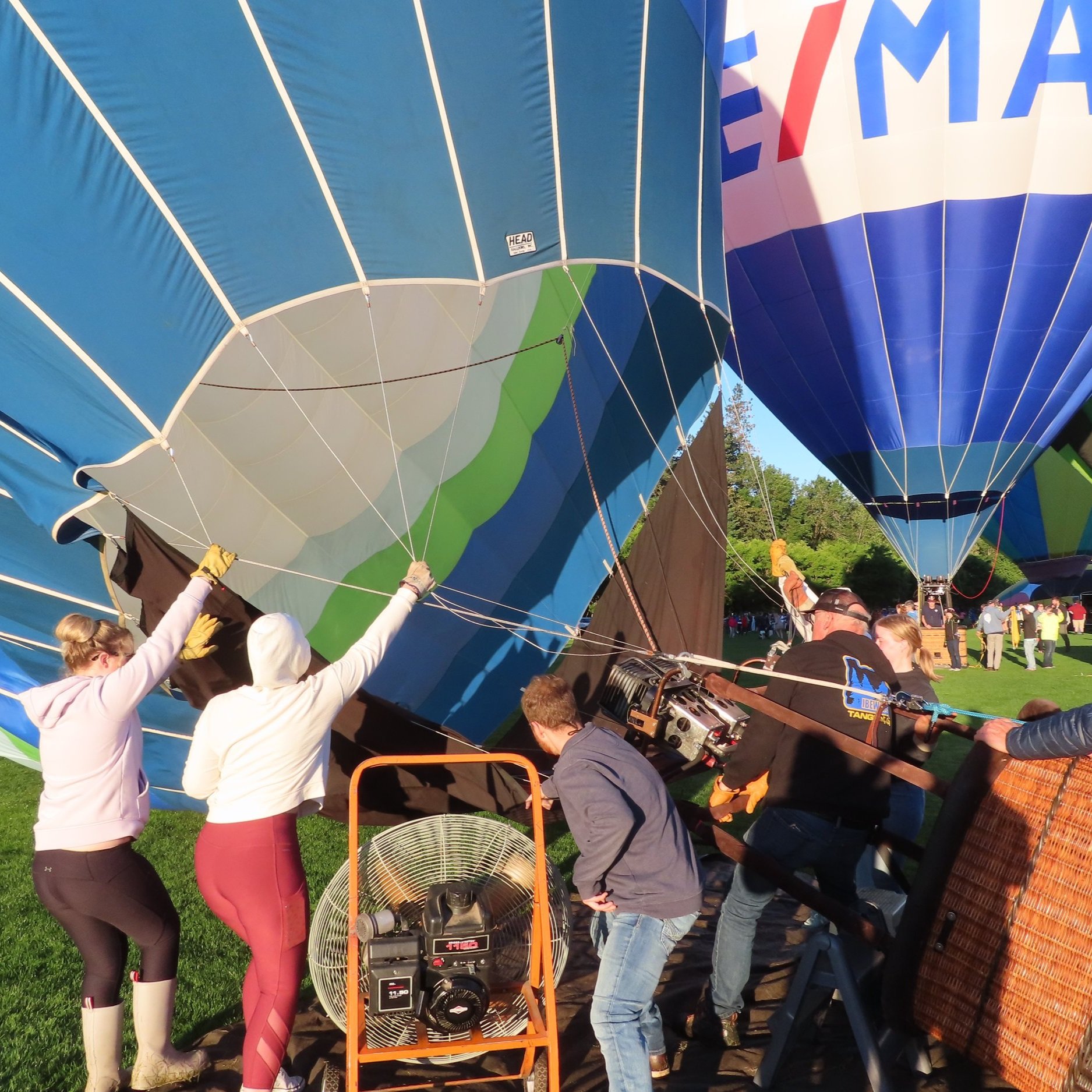Is a Hot Air Balloon an Aircraft?
Yes. A Hot Air Balloon is a type of Aircraft just as gliders, helicopters, seaplanes, fixed wing airplanes are also types of Aircraft
Are there rules?
Yes. First a Pilot must be trained to fly a Hot Air Balloon and then licensed by the FAA. Next the FAA writes the rules about how Aircraft may be flown. Balloon Pilots observe these ‘rules of the road’ just like Airline Pilots. In fact it’s the same rule book used by both.
How big are hot air balloons?
Balloons come in various sizes. The size is determined by the number of cubic feet of air that can be contained within the envelope. Sizes range from as small as 30,000 cubic feet or as large as over 300,000 cubic feet. Most have difficulty relating cubic feet to something they are familiar with. A basket ball or shoe box is about 1 cubic foot in size.
How are balloons maintained?
Pilots and Owners of Hot Air Balloons may perform some routine maintenance on their Aircraft, much like checking the air pressure or changing the oil in your vehicle. Maintenance requiring repair or disassembly of parts must be performed by licensed repair persons at licensed repair stations. The manufacturer of the Balloon determines what can be maintained by the Pilot and what must be performed by the Repair Station. In addition, the FAA determines the frequency in which all Balloons must undergo a complete inspection called an Annual Inspection.
Preparing for Flight
The balloon is prepared by spreading the envelope (the big fabric portion) out on the ground, with the basket attached to it and lying over on its side. A gasoline-powered fan is normally used to inflate the balloon with cold air until it is packed full, and then the propane burners are ignited to heat the balloon up. At this point, the balloon will slowly stand up, and then it's the ground crews' job to hold the basket down with their collective weight while the pilot continues his preflight checks and boards passengers. When all is ready to go, the pilot gives his crew the signal for "weight off," and with a few more blasts of the burner, takes to the sky!
So, how does all this work?
Basically, a balloon flies because the air inside the envelope is hotter than the air outside (known as ambient air). Although some people prefer more technical explanations, it really is that simple! The burners heat the air inside and allow the pilot to control the rate of ascent & descent. When it's time to come down, the pilot can either let the air in the envelope cool off on its own, or he can open a vent at the top of the balloon to let some air out - either way works. When it's time to land, the pilot will open the deflation port all the way to spill the air out the top and deflate the balloon. The balloon will then lie on its side and patiently wait to be packed up by the pilot and crew.
Who can fly a Balloon?
Well, anyone can fly in a balloon, but to fly one you must become an F.A.A. licensed balloon pilot. There are two levels of balloon pilot ratings. The first is a private pilot. The pilot must have at least 10 hours of flight time in free balloons; must pass a written test, oral test and flight check prior to being issued a private pilot’s license by the FAA. The second rating is a commercial pilot. The commercial pilot must have at least 35 hours of flight time in free balloons; must pass an additional written, oral and flight check prior to being issued a commercial pilot’s license by the FAA.
How do I become a pilot?
First "Official" thing to do is to apply for a Student Pilots' certificate which is needed to be able to make your solo flight and later flight tests with an examiner. To be a student pilot, you must be at least 14 years old and understand the English language, among other minor things. You might have already received and logged some ground and flight instruction at this point, but if not, what are you waiting for? The next phase is to find an instructor willing to teach you. Any commercial balloon pilot in the U.S. has the privileges of acting as balloon flight instructor, so there will be a number of pilots to help you get on your way. Training involves at least 10 hours of flight instruction, passing a written knowledge test, extensive ground instruction, and finally passing a flight examination with an F.A.A. inspector (also known as a Practical Test). Pass that, and you'll be granted your Private Pilot's Certificate for Hot Air Balloons! A private pilots' certificate allows you to take passengers up, but to be able to operate for hire, you must earn your Commercial hot air balloon pilots' certificate. This involves at least 35 hours of flight time and a much more stringent and demanding flight test.
How can I get involved?
Easy! Find a balloon pilot near you and give him or her a call or email. Most pilots will be delighted to have you come out and get involved the next time they go flying. The more help, the merrier!
What time of day do the flights take place?
Flights take place at sunrise. Hot Air Balloons are not able to fly during the day due to thermal activity, which makes the air unstable.
What type of weather conditions are needed to fly in a Hot Air Balloon?
Hot Air Balloon passenger flights take place in winds less than 10 knots, with no rain or approaching storms in the immediate area. Flights also require visibility of at least 4 km.
How do Balloons fly?
Balloons operate through the basic principles of gravity and heat transfer. As air inside the balloon is heated, it rises. As the air inside the balloon cools, it descends. To make the balloon fly, an inflator fan fills it with cool air (cold packing), which is then heated by the balloons burners. When the air is warmed to the point it is able to lift the balloon, equilibrium is achieved.
Can you steer a balloon?
Winds determine a balloon’s direction. Balloonists can steer a balloon, to a limited extent, by adjusting the balloon’s altitude to make use of different wind speeds and directions. Balloons simply float with the wind. The pilot can control the balloon's altitude to find a wind going in the desired direction, but you cannot fly upwind or crosswind. Preflight planning insures the pilot knows which way the balloon will be traveling, and the pilot makes sure there are plenty of suitable landing sites downwind.
What fuel do balloons use?
Propane in stainless steel fuel tanks. Balloons frequently carry between 10 and 60 gallons onboard. This quantity of fuel permits the 1 to 1 ½ hour flights normally experienced with a sufficient reserve supply remaining.
Why do balloons fly in the early morning and late evening?
Winds are generally most favorable the first hours after sunrise and the last hours before sunset. The sun’s uneven heating of the earth’s surface causes strong, variable winds. In the morning, it takes a few hours for the sun to heat the earth’s surface enough to generate the thermal activity that creates wind. In the evening, the sun’s intensity has diminished enough to reduce winds to acceptable flight levels. Ideal winds are 3 to 6 mph.
How high do balloons fly?
From treetop level to 2,000 to 3,000 feet, depending on what the pilot is trying to accomplish. The world record in a balloon is over 32,000 feet!
How much does a balloon cost?
New balloons can vary in size and amenities. A smaller sport balloon can run around $13,000 to $25,000 and can carry a pilot and up to 3 passengers. Commercial ride balloons are much larger and can run as much as $70,000 to $80,000 new. In addition, there’s always the cost of equipment (fans, radios, trailers, chase vehicles, etc.) in addition to the cost of the balloon.
How long does it take to inflate and deflate the balloon?
A good ground crew can inflate and launch a balloon in fifteen minutes or less. It takes about the same amount of time to deflate and pack up the balloon after the flight.
Why is the angle of the sun important?
The sun is the source of wind, because it heats the earth unevenly. Sunlight falls directly on the equator, for example. The North Pole receives weaker, slanted rays of sunlight. Clouds may keep one area cool while another heats up. Water and land heat up at different rates. Hot air is lighter than cool air, so it rises. As hot air rises, cool air slides in to replace it. The result: wind. It isn't safe to fly during the daytime when different pockets of air are rising and falling.
How do you get back to where you started?
A chase crew follows along in a van or truck. The chase crew is in radio contact with the pilot, so they can be there when the balloon lands (or soon afterwards).
What are envelopes made of?
Rip-stop nylon is the most common material. Polyester and other fabrics are sometimes used. The lower portions around the opening are usually made from a fire resistant material like Nomex, similar to what race car drivers and firemen wear. What happens if a bird flies into a balloon?




